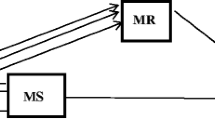Abstract
In this paper, the outage probability (OP) performance of multiple-relay-based incremental amplify-and-forward relaying device-to-device networks with transmit antenna selection (TAS) over N-Nakagami fading channels is investigated. The exact closed-form expressions for OP of the optimal and suboptimal TAS schemes are derived. The power allocation problem is formulated for performance optimization. Then the OP performance under different conditions is evaluated through numerical simulations to verify the analysis. The simulation results showed that optimal TAS scheme has a better OP performance than suboptimal TAS scheme, but the performance gap between the optimal and suboptimal schemes diminishes by increasing the number of antennas at the source; the fading coefficient, the number of cascaded components, the relative geometrical gain, the number of antennas, and the power-allocation parameter have an important influence on the OP performance.










Similar content being viewed by others
References
Mumtaz, S., Huq, K. M. S., & Rodriguez, J. (2014). Direct mobile-to-mobile communication: Paradigm for 5G. IEEE Wireless Communications, 21(5), 14–23.
Uysal, M. (2006). Diversity analysis of space-time coding in cascaded rayleigh fading channels. IEEE Communication Letters, 10(3), 165–167.
Gong, F. K., Ge, J., & Zhang, N. (2011). SER analysis of the mobile-relay-based M2M communication over double Nakagami-m fading channels. IEEE Communication Letters, 15(1), 34–36.
Karagiannidis, G. K., Sagias, N. C., & Mathiopoulos, P. T. (2007). N*Nakagami: a novel stochastic model for cascaded fading channels. IEEE Transactions on Communication, 55(8), 1453–1458.
Ilhan, H., Uysal, M., & Altunbas, I. (2009). Cooperative diversity for intervehicular communication: Performance analysis and optimization. IEEE Transactions on Vehicular Technology, 58(7), 3301–3310.
Gong, F. K., Ye, P., Wang, Y., & Zhang, N. (2012). Cooperative mobile-to-mobile communications over double Nakagami-m fading channels. IET Communications, 6(18), 3165–3175.
Xu, L. W., Zhang, H., Lu, T. T., & Gulliver, T. A. (2015). Outage probability analysis of the VAF relaying M2M networks. International Journal of Hybrid Information Technology, 8(5), 357–366.
Xu, L. W., Zhang, H., Liu, X., & Gulliver, T. A. (2015). Performance analysis of FAF relaying M2M cooperative networks over N-Nakagami fading channels. International Journal of Signal Processing, Image Processing and Pattern Recognition, 8(5), 249–258.
Laneman, J. N., Tse, D. N. C., & Wornell, G. W. (2004). Cooperative diversity in wireless networks: Efficient protocols and outage behavior. IEEE Transactions on Information Theory, 50(12), 3062–3080.
Ikki, S. S., & Ahmed, M. H. (2011). Performance analysis of incremental-relaying cooperative-diversity networks over Rayleigh fading channels. IET Communications, 5(3), 337–349.
Yang, C., Wang, W., Chen, S., & Peng, M. (2011). Outage performance of orthogonal space-time block codes transmission in opportunistic decode-and-forward cooperative networks with incremental relaying. IET Communications, 5(1), 61–70.
Xu, L. W., Zhang, H., Lu, T. T., & Gulliver, T. A. (2015). Performance analysis of the IAF relaying M2M cooperative networks over N-Nakagami fading channels. Journal of Communications, 10(3), 185–191.
Yang, L. (2010). MIMO systems with transmit antenna selection and power allocation over correlated channels. Wireless Personal Communications, 55(2), 225–235.
Suraweera, H. A., Smithnd, P. J., Nallanathan, A., & Thompson, J. S. (2011). Amplify-and-forward relaying with optimal and suboptimal transmit antenna selection. IEEE Transactions on Wireless Communication, 10(6), 1874–1885.
Yeoh, P. L., Elkashlan, M., Yang, N., Costa, D. B. D., & Duong, T. Q. (2013). Unified analysis of transmit antenna selection in MIMO multi-relay networks. IEEE Transactions on Vehicular Technology, 62(2), 933–939.
Ochiai, H., Mitran, P., & Tarokh, V. (2006). Variable-rate two-phase collaborative communication protocols for wireless networks. IEEE Transactions on Vehicular Technology, 52(9), 4299–4313.
Acknowledgments
The authors would like to thank the referees and editors for providing very helpful comments and suggestions. This project was supported by National Natural Science Foundation of China (Nos. 61304222, 61301139), Natural Science Foundation of Shandong Province (No. ZR2012FQ021), Shandong Province Outstanding Young Scientist Award Fund (No. 2014BSE28032).
Author information
Authors and Affiliations
Corresponding authors
Rights and permissions
About this article
Cite this article
Xu, L., Zhang, H., Wang, J. et al. Joint TAS/SC and power allocation for IAF relaying D2D cooperative networks. Wireless Netw 23, 2135–2143 (2017). https://doi.org/10.1007/s11276-016-1261-8
Published:
Issue Date:
DOI: https://doi.org/10.1007/s11276-016-1261-8




